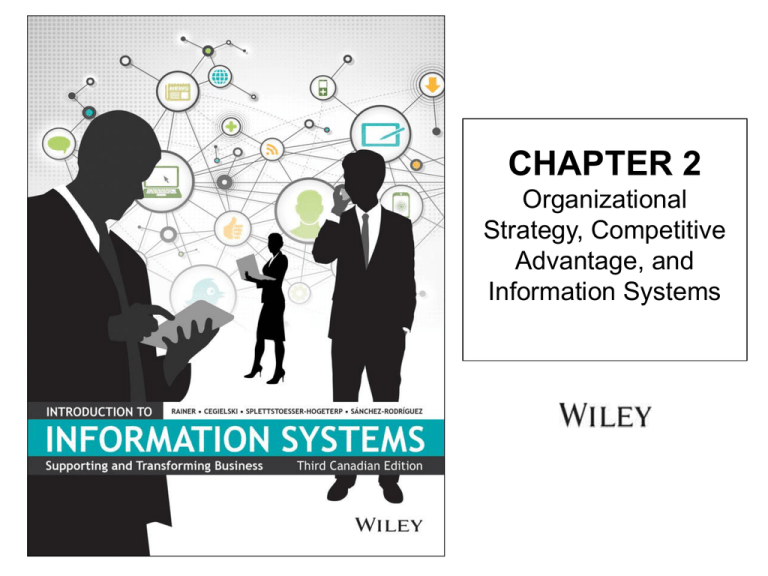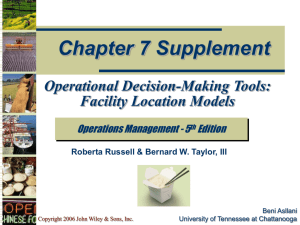
CHAPTER 2
Organizational
Strategy, Competitive
Advantage, and
Information Systems
Organizational Strategy, Competitive
Advantage, and Information Systems
2.1 Business Processes
2.2 Business Process Reengineering and
Business Process Management
2.3 Business Pressures, Organizational
Responses, and Information Technology
Support
2.4 Competitive Advantage and Strategic
Information Systems
2.5 Business – Information Technology
Alignment
Copyright John Wiley & Sons Canada
2
LEARNING OBJECTIVES
1. Understand the concept of business processes, and
provide examples of business processes in the
functional areas of an organization.
2. Differentiate between the terms business process
reengineering and business process management.
3. List and provide examples of the three types of business
pressures, and describe one IT response to each.
Copyright John Wiley & Sons Canada
3
LEARNING OBJECTIVES
(CONTINUED)
4. Identify the five competitive forces described by Porter,
and explain how the Web has an impact on each one.
5. Describe the strategies that organizations typically
adopt to counter the five competitive forces and achieve
competitive advantage.
6. Define the term business-information
technology
alignment, and describe the characteristics of effective
alignment.
7. Define the term “IT governance” and explain why
information systems need to be effectively managed
and planned.
Copyright John Wiley & Sons Canada
4
CHAPTER OPENING CASE
•
•
•
First problem:
BP was underperforming; Deasy wanted to slash IT
expenses & change IT into a strategic tool
Solution: Reduce number of IT Workers
Copyright John Wiley & Sons Canada
5
CHAPTER OPENING CASE
•
•
•
Second problem:
Deepwater Horizon well exploded
Solution: cap the spill and spend huge amounts on
public relations
Copyright John Wiley & Sons Canada
6
DISCUSSION
1. How did Deasy’s solutions for BP’s underperformance
impact the IT department?
2. Were the solutions used by BP to mitigate the damage
from the well explosion effective? Why or why not?
Copyright John Wiley & Sons Canada
7
2.1 IT’S ABOUT (SMALL)
BUSINESS
•
Websites such as Amazon.com and the Canadian startup Shopcaster (http://shopcaster.com) help retailers sell
their products through promotion online.
Copyright John Wiley & Sons Canada
8
COMPETITIVE ADVANTAGE
•
Competitive advantage is an advantage over
competitors in some measure such as cost, quality, or
speed; leads to control of a market and to larger-thanaverage profits.
Copyright John Wiley & Sons Canada
9
2.1 BUSINESS PROCESSES
•
Examples of business processes in functional areas:
•
•
•
•
•
•
•
Accounting: managing accounts payable & receivable
Finance: Producing business forecasts
Marketing: Handling customer complaints
POM: Processing physical inventory
Human Resources: Overseeing workplace safety
MIS: Training computer users
The next slide shows an example of a business
process:
• Ordering an E-ticket from an airline Web site
Copyright John Wiley & Sons Canada
10
BUSINESS PROCESSES
(CONTINUED)
Copyright John Wiley & Sons Canada
11
CROSS FUNCTIONAL PROCESSES
•
•
A cross-functional business process is one in which no
single functional area is responsible for its execution.
Multiple functional areas collaborate to perform the
process.
For example, the materials procurement process
includes all of the tasks involved in acquiring needed
materials externally from a vendor. Procurement
comprises five steps that are completed in three
different functional areas of the firm: warehouse,
purchasing, and accounting.
Copyright John Wiley & Sons Canada
12
2.2 BUSINESS PROCESS
REENGINEERING AND BUSINESS
PROCESS MANAGEMENT
•
How does an organization ensure business process
excellence?
– Business Process Reengineering (BPR) is a strategy for
improving the efficiency and effectiveness of an organization’s
business processes.
– Business Process Management (BPM) is a management
technique that includes methods and tools to support the design,
analysis, implementation, management, and optimization of
business processes
Copyright John Wiley & Sons Canada
13
2.3 BUSINESS PRESSURES,
ORGANIZATIONAL RESPONSES, AND IT
SUPPORT
•
Business Pressures:
– Market: pressures are generated by the global economy, intense
competition, the changing nature of the workforce, and powerful
customers
– Technology: pressures involving Technological Innovation and
Obsolescence and Information Overload
– Societal: includes social responsibility, government
regulation/deregulation, spending for social programs, spending
to protect against terrorism, and ethics
Copyright John Wiley & Sons Canada
14
BUSINESS PRESSURES,
ORGANIZATIONAL RESPONSES, AND IT
SUPPORT
Copyright John Wiley & Sons Canada
15
MARKET PRESSURES
•
•
•
The Global Economy and Strong Competition
The Changing Nature of the Workforce
Powerful Customers
Copyright John Wiley & Sons Canada
16
THE STAGES OF GLOBALIZATION
(FROM THOMAS FRIEDMAN IN THE WORLD IS FLAT)
•
•
•
Globalization 1.0 (from 1492 to 1800)
Globalization 2.0 (from 1800 to 2000)
Globalization 3.0 (from 2000 to the present)
Copyright John Wiley & Sons Canada
17
GLOBALIZATION 1.0
•
Christopher Columbus “discovering” the New World in
1492.
Copyright John Wiley & Sons Canada
18
GLOBALIZATION 2.0 (FIRST HALF)
•
•
Global integration during the first half of Globalization
2.0 was driven by falling transportation costs
e.g. steam engine and the railroads
Copyright John Wiley & Sons Canada
19
GLOBALIZATION 2.0 (SECOND
HALF)
•
•
Global integration during the second half of
Globalization 2.0 was driven by falling communications
costs
e.g., satellites, fiber optics, the personal computer, and
wireless smart phones
Copyright John Wiley & Sons Canada
20
GLOBALIZATION 3.0
•
•
•
1.0 – Focus on Countries
2.0 – Focus on Companies
3.0 – Focus on Groups & Individuals
Copyright John Wiley & Sons Canada
21
THOMAS FRIEDMAN’S TEN
FLATTENERS
1. Fall of the Berlin Wall
2. Netscape goes public
3. Development of work-flow software
Copyright John Wiley & Sons Canada
22
FRIEDMAN’S TEN FLATTENERS
(CONTINUED)
4. Uploading
5. Outsourcing
6. Offshoring
Copyright John Wiley & Sons Canada
23
FRIEDMAN’S TEN FLATTENERS
(CONTINUED)
7.
8.
9.
10.
Supply Chaining – Real Canadian Superstore
Insourcing – Dell, FedEx
Insourcing – Google
Informing – Ask, Bing
Copyright John Wiley & Sons Canada
24
FRIEDMAN’S TEN FLATTENERS
(CONTINUED)
The Steroids
–Computing
•Charles Babbage’s Difference Engine (1822), Modern data centre
–Instant Messaging and File Sharing
•Bit Torrent
–Voice over Internet Protocol
•Skype, Vonage
–Wireless Technologies
•Using a smart phone in motion,
Copyright John Wiley & Sons Canada
25
THE STEROIDS (CONTINUED)
–Wireless Technologies
•Using a smart phoen in motion, geostationary satellite, bluetooth
phone sunglasses
–Videoconferencing
–Computer Graphics
•Using a smart phone in motion,
Copyright John Wiley & Sons Canada
26
2.2 IT’S ABOUT BUSINESS
•
Sleek Audio
• http://www.sleek-audio.com/
•
•
Reverse Offshoring
Dynamic Innovations LLC
• http://www.d-inno.com/
Copyright John Wiley & Sons Canada
27
TECHNOLOGY PRESSURES
•
•
Technological Innovation and Obsolescence
Information Overload
Copyright John Wiley & Sons Canada
28
TECHNOLOGICAL INNOVATION
AND OBSOLESCENCE (CONTINUED)
•
•
Obsolescence: old analog camera
Innovation: digital camera
Copyright John Wiley & Sons Canada
29
SOCIETAL/POLITICAL/LEGAL
PRESSURES
1. Social Responsibility
2. Government Regulation and Deregulation
3. Protection Against Terrorist Attacks
Copyright John Wiley & Sons Canada
30
SOCIAL RESPONSIBILITY – GOING
GREEN
• IT executives listed four areas where IT is particularly
valuable for going green:
1.
2.
3.
4.
Facilities design and management.
Carbon management.
International and Canadian environmental laws
Energy management.
Copyright John Wiley & Sons Canada
31
SOCIAL RESPONSIBILITY
•
City of Vancouver
– http://vancouver.ca/
•
Canada Green Building Council
– http://www.cagbc.org/
•
One laptop per child initiative
Copyright John Wiley & Sons Canada
32
2.3 IT’S ABOUT BUSINESS
•
•
•
•
•
The Internet Facilitates Generosity
GiftFlow
Donors Choose
Kiva
Canadian Red Cross
Copyright John Wiley & Sons Canada
33
ORGANIZATIONAL RESPONSES
• Strategic Systems
• Customer Focus
• Make-to-Order and mass customization
•
See Bodymetrics video
• E-business and E-commerce
Copyright John Wiley & Sons Canada
34
2.4 COMPETITIVE ADVANTAGE AND
STRATEGIC INFORMATION SYSTEMS
1. Competitive Advantage: helps a company function
profitably within a market and generate larger-thanaverage profits.
2. Strategic Information Systems (SIS) provide a
competitive advantage by helping an organization
implement its strategic goals and improve its
performance and productivity.
Copyright John Wiley & Sons Canada
35
PORTER’S COMPETITIVE FORCES
MODEL
•
The best-known framework for analyzing
competitiveness is Michael Porter’s competitive forces
model (Porter, 1985).
Copyright John Wiley & Sons Canada
36
PORTER’S COMPETITIVE FORCES
MODEL
Copyright John Wiley & Sons Canada
37
PORTER’S COMPETITIVE FORCES
MODEL
1. Threat of entry of new competitors The threat that
new competitors will enter your market is high when
entry is easy and low when there are significant barriers
to entry.
2. The bargaining power of suppliers is high when
buyers have few choices from whom to buy and low
when buyers have many choices.
Copyright John Wiley & Sons Canada
38
PORTER’S COMPETITIVE FORCES
MODEL
3. The bargaining power of customers (buyers) is high
when buyers have many choices from whom to buy and
low when buyers have few choices.
4. The threat of substitute products or services is high
when there are many alternatives for an organization’s
products or services and low where there are few
alternatives.
Copyright John Wiley & Sons Canada
39
PORTER’S COMPETITIVE FORCES
MODEL
5. The rivalry among firms in an industry is high when
there is intense competition among many firms in an
industry. The threat is low when the competition is
among fewer firms and is not as intense.
Copyright John Wiley & Sons Canada
40
PORTER’S VALUE CHAIN MODEL
•
This model identifies specific activities where
organizations can use competitive strategies for
greatest impact.
– Primary activities
– Support activities
Copyright John Wiley & Sons Canada
41
PORTER’S VALUE CHAIN MODEL
Copyright John Wiley & Sons Canada
42
STRATEGIES FOR COMPETITIVE
ADVANTAGE
•
•
•
•
•
Cost Leadership – Walmart
Differentiation – WestJet, Dell
Innovation – CITI
Operational Effectiveness – Deloitte
Customer-orientation - Amazon
Copyright John Wiley & Sons Canada
43
STRATEGIES FOR COMPETITIVE
ADVANTAGE
Figure 2.5
Copyright John Wiley & Sons Canada
44
2.5 BUSINESS – INFORMATION
TECHNOLOGY ALIGNMENT
•
Business–information technology alignment is the
tight integration of the IT function with the strategy,
mission, and goals of the organization. That is, the IT
function directly supports the business objectives of the
organization.
Copyright John Wiley & Sons Canada
45
CHARACTERISTICS OF
EXCELLENT ALIGNMENT
• Organizations:
–
–
–
–
–
–
view IT as an engine of innovation that continually transforms
the business, often creating new revenue streams.
view their internal and external customers and their customer
service function as supremely important.
rotate business and IT professionals across departments and
job functions.
provide overarching goals that are completely clear to each IT
and business employee.
ensure that IT employees understand how the company makes
(or loses) money.
create a vibrant and inclusive company culture.
Copyright John Wiley & Sons Canada
46
CHAPTER CLOSING
• Functional areas of any organization:
–
–
–
–
are composed of a variety of business processes
must work together in an integrated fashion in order for the firm
to respond adequately to business pressures & to gain
competitive advantage in its marketplace
use a variety of strategic information systems to achieve goals
know how to analyze the organization’s strategy and value
chain, as well as the strategies and value chains of
competitors.
Copyright John Wiley & Sons Canada
47
Copyright
Copyright © 2014 John Wiley & Sons Canada, Ltd. All rights
reserved. Reproduction or translation of this work beyond
that permitted by Access Copyright (the Canadian copyright
licensing agency) is unlawful. Requests for further
information should be addressed to the Permissions
Department, John Wiley & Sons Canada, Ltd. The purchaser
may make back-up copies for his or her own use only and
not for distribution or resale. The author and the publisher
assume no responsibility for errors, omissions, or damages
caused by the use of these files or programs or from the use
of the information contained herein.
Copyright John Wiley & Sons Canada






